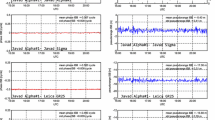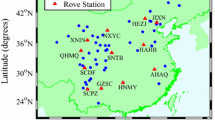Abstract
Combined GPS/GLONASS precise point positioning (PPP) can obtain a more precise and reliable position than GPS PPP. However, because of frequency division multiple access, GLONASS carrier phase and pseudorange observations suffer from inter-channel biases (ICBs) which will influence the accuracy and convergence speed of combined GPS/GLONASS PPP. With clear understanding of the characteristics of carrier phase ICBs, we estimated undifferenced GLONASS pseudorange ICBs for 133 receivers from five manufacturers and analyzed their characteristics. In general, pseudorange ICBs corresponding to the same firmware have strong correlations. The ICB values of two receivers with the same firmware may be different because of different antenna types, and their differences are closely related to frequency. Pseudorange ICBs should be provided for each satellite to obtain more precise ICBs as the pseudorange ICBs may vary even on the same frequency. For the solutions of standard point positioning (SPP), after pseudorange ICB calibration, the mean root mean square (RMS) improvements of GLONASS SPP reach up to 57, 48, and 53 % for the East, North, and Up components, while combined GPS/GLONASS SPP reach up to 27, 17, and 23 %, respectively. The combined GPS/GLONASS PPP after pseudorange ICB calibration evidently improved the convergence speed, and the mean RMS of PPP improved by almost 50 % during the convergence period.

















Similar content being viewed by others
References
Al-Shaery A, Zhang S, Rizos C (2012) An enhanced calibration method of GLONASS inter-channel bias for GNSS RTK. GPS Solut 2012(1):1–9
Bisnath S, Gao Y (2008) Current state of precise point positioning and future prospects and limitations. In: Sideris MG (ed) Observing our changing earth. Springer, New York, pp 615–623
Ge M, Gendt G, Rothacher M, Shi C, Liu J (2008) Resolution of GPS carrier phase ambiguities in precise point positioning (PPP) with daily observations. J Geod 82(7):389–399
Geng J, Meng X, Dodson AH, Ge M, Teferle FN (2010a) Rapid re-convergences to ambiguity-fixed solutions in precise point positioning. J Geod 84(12):705–714
Geng J, Meng X, Dodson AH, Teferle FN (2010b) Integer ambiguity resolution in precise point positioning: method comparison. J Geod 84(9):569–581
Geng J, Shi C, Ge M, Dodson AH, Lou Y, Zhao Q, Liu J (2012) Improving the estimation of fractional-cycle biases for ambiguity resolution in precise point positioning. J Geod 86(8):579–589
Kozlov D, Tkachenko M (1998) Centimeter-level, real-time kinematic positioning with GPS + GLONASS C/A receivers. Navigation 45(2):137–147
Kozlov D, Tkachenko M, Tochilin A (2000) Statistical characterization of hardware biases in GPS + GLONASS receivers. In: proceedings of ION GPS-2000. US Institution of Navigation, Salt Lake City, Utah, pp 817–826
Leos Mervart, Georg Weber (2011) Real-time combination of GNSS orbit and clock correction streams using a Kalman filter approach. In: proceedings of ION GNSS-2011. Institute of Navigation, Portland OR, pp 707–711
Rossbach U, Hein G (1996) Treatment of integer ambiguities in DGPS/DGLONASS double difference carrier phase solution. In: proceedings ION GPS-1996. Institute of Navigation, Kansas City, MO, pp 909–916
Tsujii T, Harigae M, Inagaki T (2000) Flight tests of GPS/GLONASS precise positioning versus dual frequency KGPS profile. Earth Planet Space 52:825–829
Wanninger L (2012) Carrier phase inter-frequency biases of GLONASS receivers. J Geod 86(2):139–148
Wanninger L, Wallstab-Freitag S (2007) Combined processing of GPS,GLONASS, and SBAS code phase and carrier phase measurements. In: proceedings of ION GNSS-2007. Institution of Navigation, Fort Worth, Texas, pp 866–875
Yamanda H, Takasu T, Kubo N, Yasuda A (2010) Evaluation and calibration of receiver inter-channel biases for RTK-GPS/GLONASS. In: proceedings of ION GNSS-2010. Institute of Navigation, Portland, Oregon, pp 1580–1587
Zheng Y, Nie G, Fang R, Yin Q, Yi W, Liu J (2012) Investigation of GLONASS performance in differential positioning. Earth Sci Inform 5(3–4):189–199
Zinoviev AE (2005) Using GLONASS in combined GNSS receivers: current status. In: proceedings of ION GNSS-2005. Institution of Navigation, Long Beach, California, pp 1046–1057
Zumberge JF, Heflin MB, Jefferson DC, Watkins MM, Webb FH (1997) Precise point positioning for the efficient and robust analysis of GPS data from large networks. J Geophys Res 102(B3):5005–5017
Acknowledgments
We thank Dr. Jianghui Geng, at University of California San Diego, for his valuable suggestions on this study. This study was supported by the National High Technology Research and Development Program of China (863 Program) (Grant No.2012AA12A202), China Postdoctoral Science Foundation (Grant No.2012M511671) and also by the Fundamental Research Funds for the Central Universities (Grant No.2012618020202).
Author information
Authors and Affiliations
Corresponding author
Rights and permissions
About this article
Cite this article
Chuang, S., Wenting, Y., Weiwei, S. et al. GLONASS pseudorange inter-channel biases and their effects on combined GPS/GLONASS precise point positioning. GPS Solut 17, 439–451 (2013). https://doi.org/10.1007/s10291-013-0332-x
Received:
Accepted:
Published:
Issue Date:
DOI: https://doi.org/10.1007/s10291-013-0332-x




